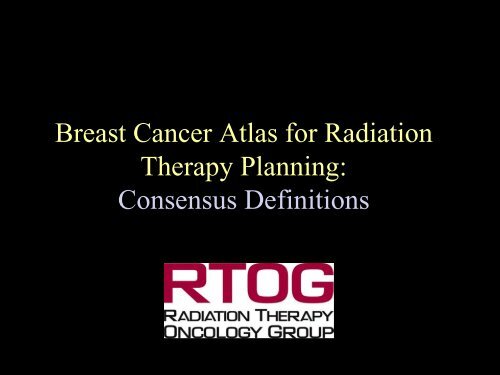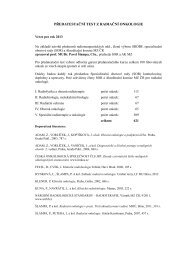Breast Cancer Atlas for Radiation Therapy Planning: Consensus ...
Breast Cancer Atlas for Radiation Therapy Planning: Consensus ...
Breast Cancer Atlas for Radiation Therapy Planning: Consensus ...
You also want an ePaper? Increase the reach of your titles
YUMPU automatically turns print PDFs into web optimized ePapers that Google loves.
<strong>Breast</strong> <strong>Cancer</strong> <strong>Atlas</strong> <strong>for</strong> <strong>Radiation</strong><strong>Therapy</strong> <strong>Planning</strong>:<strong>Consensus</strong> Definitions1
CollaboratorsJulia White 1 , An Tai 1 , Douglas Arthur 2 , Thomas Buchholz 3 ,Shannon MacDonald 4 , Lawrence Marks 5 , Lori Pierce 6 ,Abraham Recht 7 , Rachel Rabinovitch 8 , Alphonse Taghian 4 ,Frank Vicini 9 , Wendy Woodward 3 , X. Allen Li 11Medical College of Wisconsin, 2 Virginia Commonwealth University, 3 M.D.Anderson <strong>Cancer</strong> Center, 4 Massachusetts General Hospital, 5 University of NorthCarolina, 6 University of Michigan, 7 Beth Israel Deaconess Medical CenterHospital, 8 University of Colorado, 9 William Beaumont Hospital2 2
Content→ Overlying principles: slides 4 - 6→ <strong>Consensus</strong> definitions of anatomical boundaries:slides 7 - 12→ Illustrative cases:– A: Stage I intact post-lumpectomy left breast(slides 13 - 30)– B: Stage III post-mastectomy left breast(slides 32 - 51)– C: Stage III intact post-lumpectomy rightbreast (slides 54 - 71)3
Overlying principles: <strong>Breast</strong> Contour<strong>Breast</strong> CTV:– Considers referenced clinical breast at time ofCT– Includes the apparent CT glandular breasttissue– Incorporates consensus definitions ofanatomical borders (see table)– Includes the lumpectomy CTVLumpectomy GTV: Includes seroma and surgicalclips when present44
Overlying principles: Chestwall ContourChestwall CTV:– Considers referenced clinical chestwall at timeof CT– Incorporates consensus definitions ofanatomical borders (see table)– Includes the mastectomy scar (may not be feasible<strong>for</strong> occasional cases where the scar extends beyond the typicalborders of the chestwall)5
Overlying principles: Nodal volumesRegional nodal CTV:– Nodal volumes contoured <strong>for</strong> targeting willdepend on the specific clinical case– Considers consensus definitions of anatomicalborders (see table)– The three levels of the axilla can overlapcaudal to cranial– “Axillary apex” was considered level IIIof the axilla66
<strong>Breast</strong> and Chestwall Contour: Anatomical BoundariesCranial Caudal Anterior Posterior Lateral Medial<strong>Breast</strong> 1ClinicalReference+ Secondribinsertion aClinicalreference +loss of CTapparentbreastSkinExcludespectoralismuscles,chestwallmuscles, ribsClinicalReference +mid axillaryline typically,excludeslatissimus(Lat.) dorsi m.bSternalribjunction c<strong>Breast</strong> +Chestwall 2 Same Same SameIncludespectoralismuscles,chestwallmuscles, ribsSameSameChestwall 3Caudalborder oftheclavicleheadClinicalreference+loss of CTapparentcontralateralbreastSkinRib-pleuralinterface.(Includespectoralismuscles,chestwallmuscles, ribs)ClinicalReference/mid axillaryline typically,excludeslattismus dorsim aSternalribjunction b77
Contouring Comments:<strong>Breast</strong> and Chestwall1.<strong>Breast</strong>: After appropriate lumpectomy <strong>for</strong> breast onlytreatmenta.Cranial border is highly variable depending on breastsize and patient position. The lateral aspect can bemore cranial then the medial aspect depending onbreast shape and patient position.b.Lateral border is highly variable depending on breastsize and amount of ptosis.c.Medial border is highly variable depending on breastsize and amount of ptosis. Clinical reference needs tobe taken into account. Should not cross midline.8
Contouring Comments:<strong>Breast</strong> and Chestwall2.<strong>Breast</strong>-Chestwall: CTV after appropriate lumpectomy <strong>for</strong> morelocally advanced cases includes those:– With clinical stage IIb, III who receive neoadjuvantchemotherapy and lumpectomy– Who have sufficient risk disease to require post-mastectomyradiation had mastectomy done3.Chestwall: CTV after appropriate mastectomy:a.Lateral border meant to estimate the lateral border of the previousbreast. Typically extends beyond the lateral edge of thepectoralis muscles but excluded the latissimus dorsi muscleb.Clinical reference marks need to be taken into account. Thechestwall typically should not cross midline. Medial extent ofmastectomy scar should typically be included 9
Regional Nodal Contours: Anatomical BoundariesCranial Caudal Anterior Posterior Lateral MedialSupraclavicularCaudal tothe cricoidcartilageJunction ofbrachioceph.-axillary vns./caudal edgeclavicle head aSternocleidomastoid(SCM)muscle (m.)Anterior aspectof the scalenem.Cranial: lateraledge of SCMm.Caudal:junction 1 st ribclavicleExcludesthyroid andtracheaAxilla-Level IAxillaryvessels crosslateral edge ofPec. Minor m.Pectoralis(Pec.) majormuscle insertinto ribs bPlane definedby: anteriorsurface of Pec.Maj. m. andLat. Dorsi m.Anteriorsurface ofsubscapularism.Medialborder of lat.dorsi m.Lateralborder ofPec. minorm.AxillalevelIIAxillaryvessels crossmedial edgeof Pec. Minorm.Axillary vesselscross lateraledge of Pec.Minor m. cAnteriorsurface Pec.Minor m.Ribs andintercostalmusclesLateralborder ofPec. Minorm.Medialborder ofPec. Minorm.AxillalevelIIIPec. Minorm. insert oncricoidAxillary vesselscross medialedge of Pec.Minor m. d.Posteriorsurface Pec.Major m.Ribs andintercostalmusclesMedialborder ofPec. Minorm.ThoracicinletInternalmammarySuperioraspect of themedial 1 st rib.Cranial aspectof the 4 th rib- e. - e. - e. - e.
Contouring Comments:Regional Nodal Volumesa.Supraclavicular caudal border meant to approximate thesuperior aspect of the breast/ chestwall field borderb.Axillary level I caudal border is clinically at the base ofthe anterior axillary linec. Axillary level II caudal border is the same as the cranialborder of level 1d. Axillary level III caudal border is the same as thecranial border of level IIe.Internal Mammary lymph nodes: encompass theinternal mammary/ thoracic vessels11
Case A- Intact post lumpectomy breast• Stage I ( T1c, N0, M0) Left breast cancer• Surgery: Lumpectomy and sentinel node biopsy• <strong>Radiation</strong>: <strong>Breast</strong>• Six surgical clips placed at lumpectomy site• External markers placed at time of CT:– BB at AP set-up point– 4 wire markers <strong>for</strong> clinical estimate of cranial, caudal,medial, and lateral extent of anticipated tangents– Wire extending from 9-3 o’clock around the inframammaryfold– Wire over the lumpectomy scar12
1616
Case B: Post-mastectomy, Stage III• Stage IIIB (T-3, N-3, M-0) left breast cancer, tumor size7 cm, 11/15 nodes positive• Surgery: total mastectomy and axillary done dissection• <strong>Radiation</strong>: chestwall + regional lymph nodes• External wires present on CT:– Wire on mastectomy scar– BB on AP set-point at clinically estimated level of thematch <strong>for</strong> the supraclavicular + axilla with thechestwall + IMC fields– Wires at lateral and inferior clinically estimated extentof the chestwall 31
3535
Case C: Stage III- Intact breastpost lumpectomy• Stage IIIA (T-2, N-2, M-0) right breast cancer, tumor size 3 cm,4/18 nodes positive• Surgery: Lumpectomy and axillary node dissection• <strong>Radiation</strong>: <strong>Breast</strong>, chestwall + regional lymph nodes• External wires present on CT:– Wire on lumpectomy scar– BB on AP set-point at clinically estimated level of the match <strong>for</strong>the supraclavicular + axilla with the chestwall + IMC fields– Wire extending from 9-3 o’clock around the infra-mammary fold– Wires at lateral and inferior clinically estimated extent of thechestwall5252



![Anatomic distribution of [18F] fluorodeoxyglucose-avid lymph nodes ...](https://img.yumpu.com/51788410/1/190x255/anatomic-distribution-of-18f-fluorodeoxyglucose-avid-lymph-nodes-.jpg?quality=85)
